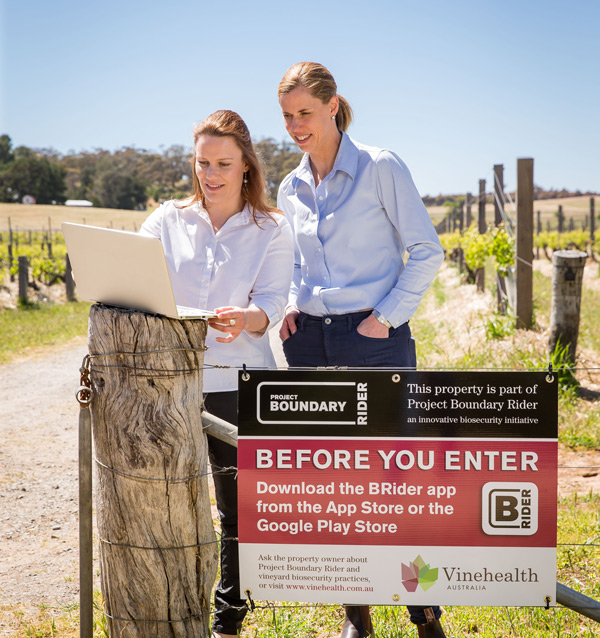Vinehealth Australia’s Boundary Rider pilot project has demonstrated the power of geofencing as a concept to assist our wine and grape industries in their biosecurity efforts.
The innovative pilot project was undertaken with 31 businesses in McLaren Vale and Barossa who assessed the value proposition of geofencing technology for biosecurity over a five month period.
The geofencing software for the trial was provided by the Canadian technology provider, Be Seen Be Safe, and was adapted as a minimum viable product from the poultry industry. Virtual fences (geofences) were placed around 129 separate land parcels. Movements of people carrying a smartphone with a purpose-built App and Location Services enabled, were logged crossing into and out of each geofence.
Push notification messages notified the owner/manager of the visitor and welcomed the visitor to the vineyard. The visitor movements were collated into an electronic visitor book for each geofence, providing the visitor name, date of visit, timestamp and visit duration.
The total number of boundary crosses for the pilot was 4,194 pairs, with a pair being an ‘in’ and ‘out’ of the same geofence by the same visitor.
Despite some technical difficulties with the software, participant feedback was generally positive about the value geofencing could offer vineyard businesses and regulators such as Vinehealth Australia as an added tool to assist in the protection and management of significant pest and disease incursions.
Following the pliot, a range of vital attributes were identified by participants for future geofencing systems:
- A geofencing system with biosecurity at its core.
- A system that is easy to adopt and has a strong value proposition for all users.
- 100% (or as close to as possible) uptake in regions to be an effective management system for biosecurity.
- A system that users employ 24/7 with no down times.
- A system that assists and drives owners/managers to prioritise simple biosecurity activities in day to day vineyard operations.
- A system that aids owners/managers to complete compliance checks of machinery and equipment.
- A system that openly addresses privacy and successfully negates the ‘big brother’ issue.
- A minimum cost (time and money) solution to ensure system longevity and maintenance of high uptake.
- A system produced by local developers in the same (or very similar) time zone, tailored to the needs of the wine industry, with capacity to implement system changes rapidly.
- A system which incorporates highly accurate and sensitive geofences, the exact location and relative accuracy of which are customisable by property owners. This includes use of high resolution Australian base map imagery and Vinehealth’s accurate block boundary layer.
- A system which utilises the same geofence around a land area for both incoming and outgoing visitor tracking.
- A system which allows owners/managers to receive real-time notifications of visitors crossing geofences via push notifications or similar, and this translates also to real-time visitor logbook records.
- A system which allows ‘on the go’ viewing of the electronic visitor logbook.
- A system with the capability of tracking machinery and equipment, not just people.
- An electronic system into which manual visitor logbook records can be easily and rapidly integrated, so all visitor records are stored in a single system.
- A system with vastly reduced battery draw in comparison to that of Project Boundary Rider.
- A system which allows for the tracking of people over a geofence where smartphone location services has not been enabled.
- A system which allows for the tracking of people over a geofence where the visitor does not have a smartphone.
- A system which allows visualisation of the visitor logbook and where the data can be exported and integrated into financial systems to facilitate payment of staff or service providers.
- A system in which if user registration is required, this process is simple, quick and works first time every time on all phones (types and ages) and search engines.
- A system which allows for two-way customised push notification messaging, including for owners/managers to communicate different requirements of entry for different visitor types and ability to turn off messaging for chosen visitors/visitor types.
“This pilot study has positioned us well to further consider the benefits of geofencing to manage future industry biosecurity imperatives,” said Suzanne McLoughlin, Vinehealth Australia Technical Manger and project coordinator.
“Australia’s biosecurity landscape is changing, which is influencing the types of risks we face and our available options to manage these risks. Maintaining preparedness and agility is of utmost importance and we need to consider the approriate role for technology in this landscape, to complement other farm-gate hygiene tools and biosecurity education and awareness programs.”
Vinehealth Australia thanks PIRSA for their encouragement, Be Seen Be Safe for their support with technology and all participating businesses and contributors to the project.
For more information click here to read the media release or contact us for a copy of the final report.
